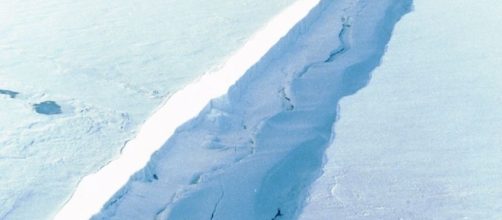A gigantic chunk of ice the size of Delaware is hanging by a sliver in the Antarctic and once it breaks away and drifts free scientists said the entire remaining shelf could be in danger of breakup.“If it doesn’t go in the next few months I’ll be amazed,” said Prof Adrian Luckman, in a BBC News Report. Luckman is a scientist with Swansea University located in Wales, UK.
The big iceberg is ready to go out on its own
According to reports a mere frozen appendage is all that is keeping the mass titled Larsen C in place. The soon-to-be berg is a big part of the most northern major shelf in Antarctica.
Larsen C is at the west edge of the Antarctic and has acted as a huge gate stopping and holding glaciers that feed into it. The potential breakup follows on the heels of other major breaks that took place in the region in 1995 and 2002. However, scientists said this breakaway would be among the top 10 biggest icebergs ever recorded.
In terms of size Larsen C is about 2,000 square miles and is being restrained from becoming a free-floating iceberg by a mere 12-mile chunk of ice. The first sign the event was taking place was the spotting and tracking of a “rift,” a giant crack in the shelf extending 70 miles, 300 feet wide and about a third of a mile deep, clearly visible from the air. Scientists predicted the breakaway will cause the shelf to lose about 10 percent of its total.
Like a massive floating island, the Anarchic shelf scientists said could raise global sea levels if the ice that Larsen C is holding back entered the sea as individual icebergs. “The eventual consequences might be the shelf collapsing in years to decades,” Luckman said in the BBC report. Luckman said the resulting sea rise from such a worst-case event could eventually raise ocean levels four inches.
The breakoff will not cause ocean levels to rise immediately because Larsen C is floating on the sea already. Glaciers customarily move downward off the land and enter the sea forming into shelves. The scientists said while the event is not catastrophic and can occur normally, this one is spectacular for its size and would be considered a rare occurrence.
None of the scientists in the reports attributed the break to the impact of global warming.
Ocean levels will not rise immediately from the iceberg event
However, scientists had said after an earlier break it was due to warming global air temperatures. Though scientists decline to predict immediate dire consequences from the Larsen C breakaway, they did say the event would signal a major change in the coastline of the Antarctic. Thus the landscape of one of the planet’s two global frozen caps would be altered. Luckman added there is little doubt the breakoff will make the remaining shelf less stable. Scientists refer to iceberg formation as “calving.”

